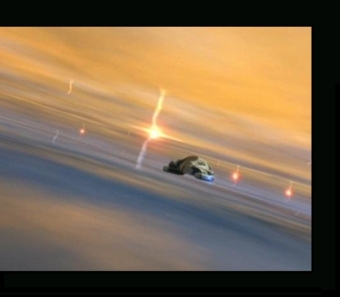|

An interfold layer is an unstable realm located in some
regions of space. It is not contained within normal space or subspace,
but in the confluence of the two. A region, where such a layer exists,
was first encountered in 2373 by USS Voyager in the Delta Quadrant.
It's existence was first detected when a probe was trapped inside it by
an astral eddy that collapsed back into the layer. The probe became
undetectable, but was still transmitting telemetry from within the
layer. While Tom Paris was gathering plasma particles, with the bussard
collectors of the class 2 shuttle Cochrane, from the wake of an astral
eddy, the shuttle was also pulled into the interfold layer by a
collapsing eddy. This interfold layer was discovered to be the spawning
ground of the astral eddies and found to contain thousands of small
eddies. By piloting the shuttle to the eye of an erupting larger eddy,
Paris was able to ride to the leading edge of the eddy and back into
normal space. (VOY: "Real Life")
Images used to illustrate astral eddies in Star Trek
very clearly indicate a phenomena similar to Black Holes, so an
interfold layer could be thought to be a spawning ground where Black
Holes can be formed. In actual astrophysics, Black Holes are made when
very large stars die. When the star runs out of fuel for nuclear
burning in the core it is no longer able to support itself from
collapsing under its own weight. The star first collapses and then the
outer layers rebound to form a supernovae explosion. What's left at the
core is a Neutron Star or a Black Hole depending on the initial mass of
the star. To form a Black Hole the mass left at the core after the
explosion must be more than about 3 times the mass of the Sun. The star
for most of its life probably needds to be between 50 to 100 times the
mass of the Sun to eventually form a Black Hole.
|
|
